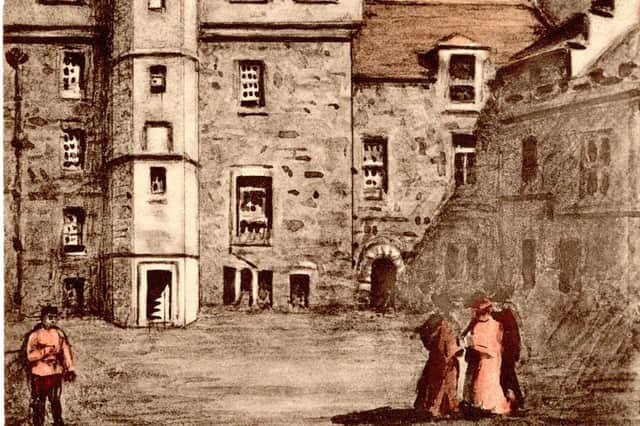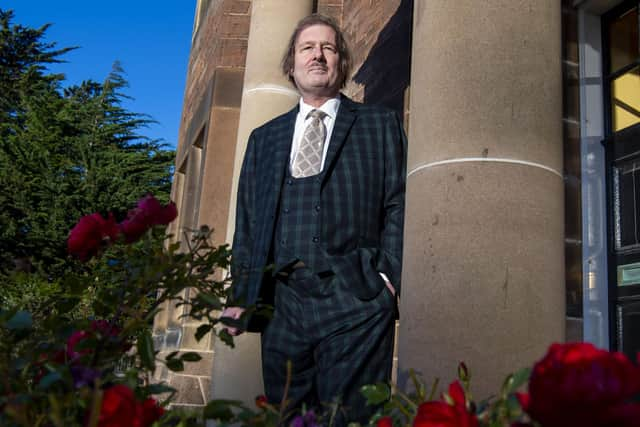Mystery of the child's bones hidden in Edinburgh Castle walls – Part 2


‘In making some repairs to the west front at the royal apartments in the year 1830, a remarkably curious and interesting discovery was made. Nearly in a line with the crown-room, and about six feet from the pavement of the quadrangle, the wall was observed, when struck, to sound hollow, as though a cavity existed at that place. It was accordingly opened from the outside, when a recess was discovered, measuring about two feet six inches by one foot, and containing the remains of a child, enclosed in an oak coffin, evidently of great antiquity and very much decayed.
'The remains were wrapped in a cloth, believed to be woollen, very thickly wove, so as to resemble leather, and within this were the decayed fragments of a richly embroidered silk covering, with two initials wrought upon it, one of them distinctly marked ‘I’. This interesting discovery was reported at the time to Major General Thackery RE, by whose orders they were again restored to their strange place of Sepulture, where they still remain. It were vain now to attempt a solution of this mysterious discovery, though it might furnish a novelist with material on which to found a thrilling romance.'
Advertisement
Hide AdWhen Sir Daniel Wilson’s Memorials of Edinburgh were issued in a new edition in 1891, the section about the discovery of the coffin was retained without change, including the part about the coffin and bones being re-interred in the wall, which is certainly erroneous since there is contemporary evidence that many bones, as well as fragments of wood and cloth, were taken as souvenirs, some of them ending up in the repository of the Society of Antiquaries, from which they have since been lost or discarded.


Fast forward 40 years, with no worthwhile attention given to the castle mystery, until the London Morning Post retold the story in 1888, adding further inaccuracies as it went along.
Ludicrously, the journalists were unable to pick the right Edinburgh royal palace when there were just two to choose from, placing the mystery at the Palace of Holyroodhouse and not at the castle. When the Scotsman corrected this mistake, some interesting correspondence came to light. In particular, a certain PH M’Kerlie wrote that the story was not some invention by the castle tour guides but founded on solid fact. The oak coffin with the remains of a child had been found 'in the front wall, royal apartments square, Edinburgh Castle, nearly in line with the Crown Room, about five or six feet above the floor, in the apartment occupied by the messman …'
Several officers and soldiers from the garrison had taken care of some bones and fragments of coffin, as well as the cloth, said to be silk, on which two letters had been embroidered, one of them a ‘I’ or ‘J’.
Being a lad at the time, M’Kerlie was given some of the bones for his collection of curiosities. The inevitable sceptic wrote to the Scotsman, saying that M’Kerlie was a credulous fool since 'he believed the story, which it is understood the castle guides occasionally venture to palm upon the credulous tourist that the remains found in the mysterious chamber in the wall were those of the real James VI. These lead up to the conundrum, who was the other fellow that actually occupied the throne?'
M’Kerlie remained adamant, however, that the story was nothing but fact, although the bones he had got for his private museum had disappeared long ago.
Advertisement
Hide AdIn 1907, after a London newspaper had briefly discussed the castle mystery, several correspondents to the Notes & Queries debated the veracity of the story, some believing that Mary Queen of Scots had given birth to a stillborn child, the remains of which had been coffined and immured in the wall, to be replaced in the crib by the offspring of a soldier’s wife. A sceptic rightly concluded that there was nothing to link the discovery of the remains with Mary Queen of Scots or with her little son and speculated that the bones were those of some animal immured in the wall to ward off evil spirits.
In 1909, the antiquary Walter B Woodgate reviewed the old story of the coffin in the wall and swallowed it hook, line and sinker. Since he thought James VI very much resembled the Earl of Mar, he suggested that the child of the Countess of Mar had been substituted for the stillborn little prince.
Advertisement
Hide AdIn 1918, the story was given careful consideration by the dowager Lady Forbes. She reasoned that the murder of Rizzio at Holyrood, in front of the eyes of the pregnant Mary Queen of Scots, surely must have induced a fearful ‘maternal impression’, weakening the little prince until he would become incapable of extrauterine life.
She speculated that Lady Reres, a middle-aged lady of the court who appears to have been some kind of royal wet-nurse, had given birth at about the same time as Mary, and that a group of conspirators got rid of the body of the stillborn little prince, and put young Reres in the royal crib in his stead, without Mary’s knowledge.
Commenting on her Ladyship’s writings, Professor RK Hannay pointed out that there was nothing to suggest that Reres was pregnant at the time, and that there is evidence that she was quite an unwholesome woman. And if the conspirators wanted the dead little prince to disappear for good, why then take the trouble to embroider ‘JR’ (for Jacobus Rex) on his silken shroud?
Tomorrow: Animal bones, human remains or holy relic
This is an edited extract from Jan Bondeson’s book Phillimore’s Edinburgh, published by Amberley Publishing
A message from the Editor:
Thank you for reading this article. We're more reliant on your support than ever as the shift in consumer habits brought about by coronavirus impacts our advertisers.
If you haven't already, please consider supporting our trusted, fact-checked journalism by taking out a digital subscription
Comments
Want to join the conversation? Please or to comment on this article.